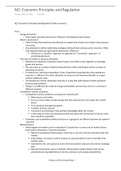Tentamen (uitwerkingen)
ATLS PRE TEST 2022 10th Edition ( 100% CORRECT ANSWERS ) A+ GRADED VERIFIED
- Vak
- Instelling
1. A 22-year-old man is hypotensive and tachycardic after a shotgun wound to the left shoulder. His blood pressure is initially 80/40 mm Hg. After initial fluid resuscitation his blood pressure increases to 122/84 mm Hg. His heart rate is now 100 beats per minute and his respiratory rate is 28 b...
[Meer zien]












